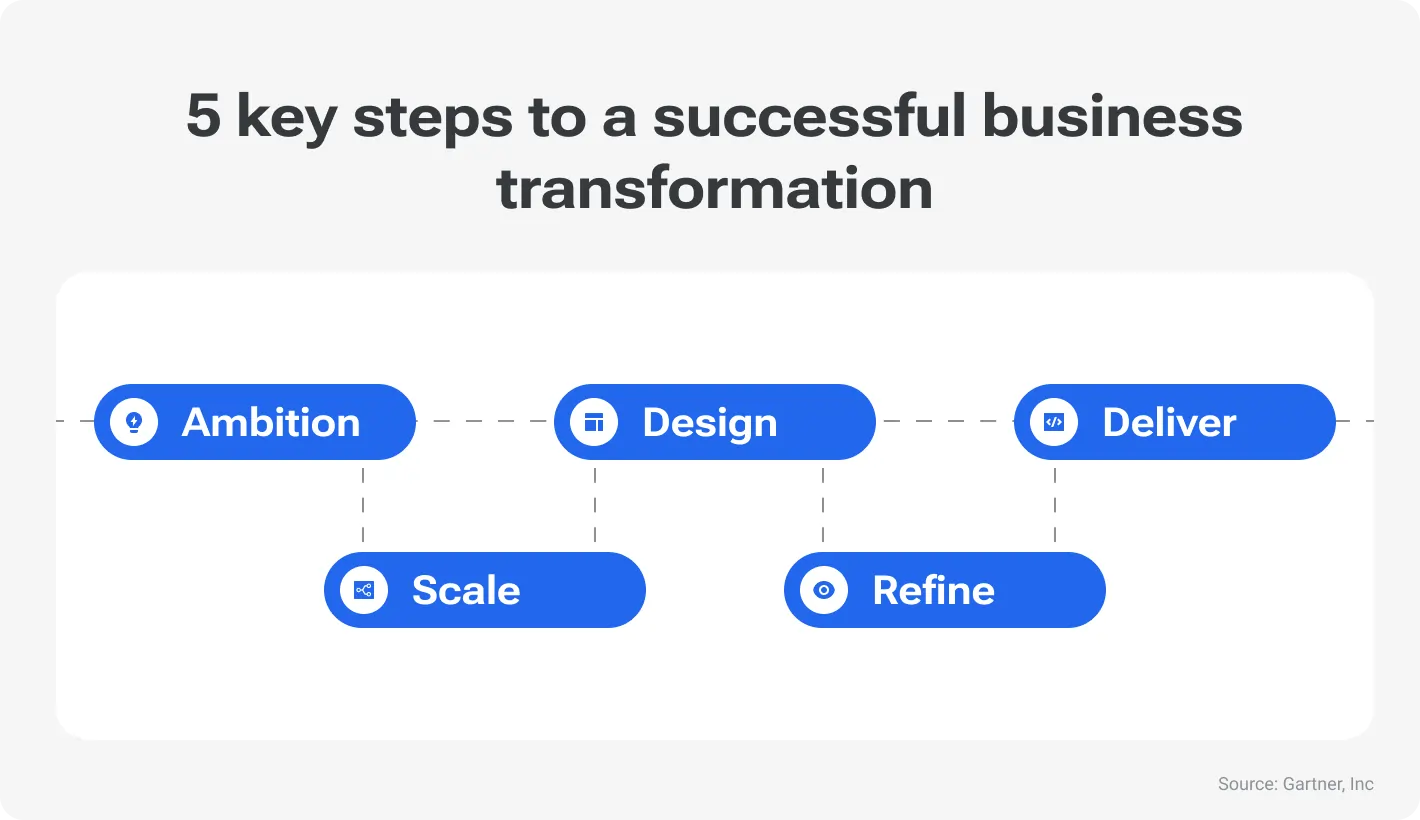Outsourcing to Czechia

How much does it cost to hire developers in Czechia?
Dec 2nd 25 - by Devico Team
Find out how much it costs to hire software developers in Czechia in 2025. Compare hourly rates, roles, and factors that impact pricing.
Hire
Hire by role
Hire Front-end developers
Hire Back-end developers
Hire Full-stack developers
Hire Android developers
Hire iOS developers
Hire Mobile developers
Hire AI engineers
Hire ML engineers
Hire Automation QA engineers
Hire Blockchain developers
Hire Data engineers
Hire Cloud engineers
Hire by skill
Hire JavaScript developers
Hire TypeScript developers
Hire Ruby on Rails developers
Hire React Native developers
Hire Flutter developers
Hire Golang developers
Hire React.js developers
Hire Python developers
Hire PHP developers
Hire .NET developers
Hire Java developers
Hire Laravel developers

BOT
August 19, 2024 - by Devico Team
Summarize with:
As you know, Netflix used to be a DVD-by-mail service, but now it is a global streaming giant. This transformation is a testament to the power of digital innovation. A data-driven approach, investing in technology, and prioritizing customer experience — this is what made Netflix an icon in the entertainment industry. However, such transformations are no longer a luxury but a necessity for businesses to thrive in today’s business environment.
Digital transformation involves leveraging digital technologies to create new – or modify existing – business processes, culture, and customer experiences. And central to this digital evolution is the Build-Operate-Transfer (BOT) model. The model or the approach offers a strategic framework for companies to optimize their IT infrastructure and operations, aligning them with the demands of the digital age.
McKinsey Global Institute reports digital transformation (and the AI industry in particular) has the potential to add up to USD 4.4 trillion to the global economy annually. By understanding and effectively implementing the BOT model, organizations can position themselves to capture a significant share of this value.
This article is your aid on that journey. It’s all about the benefits and challenges of the BOT model and successful digital transformation initiatives. We'll explore how to leverage its potential, crush challenges, and ultimately, achieve business objectives.
In some terms, we can compare the BOT model to a relay race. Just as each runner in a relay race must efficiently pass the baton to the next to achieve success, the BOT model’s structured and phased approach ensures a smooth transition through building, operating, and eventually transferring the new digital capabilities to the client.
On the other hand, if digital transformation is building up a new house, the Build-Operate-Transfer is a technology roadmap.
This is where we lay the foundation of the digital transformation. First, we set up the necessary infrastructure, then select technology stacks, and finally recruit the right talent.
Alignment: This phase aligns with the goals of digital transformation, a la the design-and-planning stage. It ensures that the most suitable technologies are implemented from the start. It sets the stage for new digital processes and systems.
Example: When a retail company wants to implement an e-commerce platform, the build phase would have several sub-steps like setting up the website, integrating payment gateways, and establishing inventory management systems.
The operate phase mirrors the execution-and-optimization stage, where your outsourcing partner manages day-to-day operations:
optimizes processes
implements process improvements
automates tasks and eliminates waste.
Also, the external partner documents and maintains knowledge bases and ensures performance metrics are met.
Alignment: This phase ensures that the new digital systems run smoothly and efficiently. Continuous optimization helps refine the processes and technologies, ensuring they meet the business goals.
Example: For the same retail company, the operate phase would involve managing the e-commerce platform, ensuring uptime, handling customer queries, and optimizing the user experience.
This is where control and ownership are handed over to the client’s internal team. Typically, this step consists of comprehensive training, documentation handover, and a phased withdrawal of the external partner.
Alignment: This phase is a knowledge transfer-and-sustainability stage that ensures the client’s team is fully equipped to manage and evolve the digital systems independently. Such a step celebrates sustainability and long-term success.
Example: The retail company’s IT team takes over the management of the e-commerce platform, supported by thorough documentation and training provided by the external partner.
Rapid technology implementation: The BOT model is about speeding up the digital transformation process. According to the 2020 Deloitte digital transformation survey, companies that leverage external expertise speed up implementing digital solutions compared to those relying solely on internal resources.
Risk mitigation: Businesses can mitigate risks associated with new technology implementations by involving an experienced external partner. The external partner’s expertise reduces the chances of costly errors and ensures compliance with industry standards.
Access to expertise: You gain access to a pool of experts who are well-versed in the latest technologies and best practices. No matter where you are situated, no matter what your industry is, you can rest assured that digital transformation is carried out using cutting-edge solutions and methodologies.
The structured approach of the BOT model ensures a smooth transition through the phases of digital transformation and provides a significant enhancement to the overall effectiveness of your efforts.
The ABC of any digital strategy is a clear understanding of your goals and objectives. Dive deeper into your business strategy and identify areas where digital technology can create a competitive advantage.
The first step in an IT modernization campaign is defining clear and measurable goals. They should align with your overall business strategy and provide a clear step-by-step guide for your digital initiatives.
How to define goals: Get the ball rolling by identifying the key areas where digital transformation can add value. Speaking from experience, common areas include improving customer experience, enhancing operational efficiency, or enabling data-driven decision-making. Use the SMART approach (Specific, Measurable, Achievable, Relevant, Time-bound) to define each goal. For example, a goal might be to increase online sales by 20% within one year by implementing an AI assistant in the e-commerce platform.
Why is alignment so important: Because we are used to measuring success in business mainly by revenue, innit? By contributing directly to your company’s long-term objectives. Such an alignment secures buy-in from stakeholders and ensures that resources are allocated effectively.
Choosing the right technology stack and digital tools is crucial for the success of your digital transformation. Equally important is selecting a reliable BOT partner who can guide you through the process.
Criteria for technology selection: Factor in scalability, compatibility with existing systems, and support for future growth. Some of the key tools are:
AWS/Azure/Google Cloud: For ensuring the latter — future growth (regarding cloud infrastructure).
Salesforce: For customer relationship management (CRM).
Power BI/Tableau: For data analytics and visualization.
Jira/Trello: For project management and collaboration.
Choosing a BOT partner: Look for a partner with proven expertise in digital transformation. Check their track record: case studies, client testimonials, personal interviews (including previous clients), and industry certifications. Gartner's report states: 87% of senior business leaders believe digitalization is a company priority, yet only 40% of organizations have brought digital initiatives to scale.
It begins with setting up the technology and infrastructure necessary for your digital transformation. This phase lays the foundation for all next activities.
Technology setup: Installation and configuration of the selected technology stack.
Infrastructure development: Developing the necessary IT infrastructure, including servers, databases, and network configurations.
Initial system implementation: Keeps up with implementing the core systems that will drive your digital transformation, such as CRM, ERP, or data analytics platforms.

Week 1-2: Finalize technology selection and procurement.
Week 3-4: Set up and configure the technology stack.
Week 5-6: Develop and test the IT infrastructure.
Week 7-8: Implement initial systems and conduct preliminary testing.
Confirm technology compatibility with existing systems.
Ensure scalability and future-proofing of the infrastructure.
Establish integration points between new and existing systems.
Conduct thorough testing to identify and address any issues early.
During this phase, the outsourcing partner double-checks every link in the chain of operations to ensure everything runs smoothly. Pay attention to the partners’ actions: they should aim for smooth technology adoption, system improvements, and process optimization.
System optimization: Continuously refine and optimize the systems to enhance performance: update software, fine-tune configurations, and address any issues that arise.
Process improvements: Streamline workflows and processes to ensure they are aligned with the new digital systems. This might involve automating repetitive tasks and refining operational procedures.
Performance monitoring: Use monitoring tools like Nagios, Datadog, or New Relic to track system performance. Regularly review performance metrics to identify areas for improvement.
Although this may sound totally obvious, you should pay special attention to the feedback from users and stakeholders when refining digital solutions. There are no improvements without such feedback, and poor communication can derail this process.
For example, the UK’s National Health Service (NHS) encountered significant issues with its digital patient records system due to inadequate stakeholder feedback and poor communication between IT teams and healthcare professionals. Even though behemoths like Accenture and Atos Origin were involved, this led to widespread dissatisfaction and approximately GBP 6B loss.
In this stage, your BOT executor must hand over knowledge and ownership from them to the internal team. This phase aims at ensuring that the internal team is fully equipped to manage the new systems independently.
Knowledge transfer: Comprehensive training sessions help ensure that the internal team understands the new systems. These may be hands-on training, theoretical sessions, or real-time problem-solving exercises.
Documentation handover: Partner provides detailed documentation for all systems and processes. This should include user manuals, system architecture diagrams, and operational procedures.
Change management: Implement effective change management strategies to ensure a smooth transition. And this is where clear communication comes into play. It’s about the benefits of the new systems, addressing any concerns from the internal team, and providing ongoing support.
Training programs: Use a mix of in-person and online training sessions. Interactive modules and quizzes can help reinforce learning. Some research shows that gamification helps enhance the learning and memorizing process by 40%.
Mentorship schemes: Pair internal team members with experts from the BOT partner to provide ongoing support and guidance.
Regular updates: Keep all stakeholders informed about the progress of the transfer and any upcoming changes.
Measuring is the key in almost any endeavor including the BOT initiatives. For this reason, you should understand KPIs' impact and identify areas for further improvement.
System uptime: Track the availability and reliability of the new systems.
User satisfaction: Use surveys and feedback tools to gauge user satisfaction.
Operational efficiency: Measure improvements in workflow efficiency and productivity.
Regular assessments: Regularly check your system’s health to identify areas for improvement and ensure that the systems continue to meet business needs.
Continuous improvement: Continuous learning and improvement are key. Gather feedback and encourage its provision to spark innovations. Regularly update systems and processes to keep up with technological advancements.
Strategic planning: Develop long-term plans for scaling digital solutions across different departments and business units. This ensures that the benefits of digital transformation are sustained over time.
GE set their eyes on modernizing the entire industry. As a genuine leader, they wanted to lead by example. However, the company needed to integrate digital technologies to improve efficiency, reduce costs, and – most importantly – reignite innovation. Nonetheless, at that moment (starting in 2008) GE's existing IT infrastructure was fragmented, and the company lacked the necessary digital skills internally to lead a comprehensive transformation.
GE adopted the outsourcing approach (particularly the BOT model) to facilitate the changeover. The company teamed up with a service IT company to implement the transformation.
During the build phase, the outsourcing partner helped GE develop a new digital platform, Predix, which served as an industrial IoT (Internet of Things) platform. They set up the required infrastructure and recruited specialized talent to manage the initial development.
In the operate phase, they managed the day-to-day operations of the Predix platform, optimizing processes and ensuring the platform's performance. Considering feedback they applied an iterative approach to refine the platform during this phase.
Finally, in the transfer phase, knowledge and operational control were transferred back to GE's internal teams through comprehensive training and detailed documentation.
The BOT model enabled GE to launch Predix successfully, which led to significant improvements in operational efficiency and cost reductions across various business units. The platform also allowed GE to offer new services to its clients, driving additional revenue streams.
Moreover, after their own transformation, they were able to spread the change to their clients. This is how they saved over USD 2.4M for gas gas-producing company in Qatar.
Strategic partnerships: Collaborating with experienced partners can fill skill gaps and accelerate digital transformation.
Iterative improvements: Continuous feedback and iteration are essential for optimizing digital solutions.
Comprehensive training: Effective knowledge transfer and training are crucial for sustaining long-term benefits.
A global sportswear giant used a BOT model to optimize its supply chain operations. The goal was to improve inventory management, reduce lead times, and enhance responsiveness to market demands.
The main challenge lies in managing complex supply chains with multiple suppliers (so-called “plants”), distribution centers, and retail stores. The main need was improving forecasting accuracy, reducing stockouts, and optimizing transportation routes.
Nike partnered with a logistics provider to implement a BOT model for supply chain management.
The build phase focused on developing a robust supply chain platform with advanced analytics capabilities.
The operate phase involved real-time monitoring of inventory levels, optimizing transportation routes, and implementing demand forecasting models.
The transfer phase ensured the retailer's internal team gained the necessary skills to manage the platform independently.
This outsourcing endeavor of footwear manufacturing attracted independent contract manufacturers in 14 countries so Nike has minimized its manufacturing overhead and reduced costs by USD 0.15 per unit.
This lean supply chain approach enabled Nike to move over 900M units per year. The company's reliance on external partners has also allowed it to consolidate its intermediate costs by limiting the number of vendors with whom it must negotiate contracts.
Leverage data analytics and AI (now it’s more than possible) to optimize supply chain operations.
Build strong partnerships with logistics providers to enhance supply chain visibility.
Focus on end-to-end supply chain optimization, from sourcing to delivery.
The BOT model can be effectively leveraged for digital transformation since it provides clear benefits and long-term value.
The Build-Operate-Transfer model can effectively drive digital transformation initiatives. Its structured and phased approach ensures rapid implementation, risk mitigation, and access to expertise that hardly can be accessed through other methods.
Run through the roadmap to refresh your memory of essential steps for leveraging the BOT model, from setting clear goals to selecting the right technology and partners, managing the operating phase, ensuring a smooth transfer, and measuring success. The BOT model is a powerful tool for companies looking for IT modernization and enhancing their digital capabilities.
Outsourcing to Czechia

Dec 2nd 25 - by Devico Team
Find out how much it costs to hire software developers in Czechia in 2025. Compare hourly rates, roles, and factors that impact pricing.
Outsourcing to Czechia

Nov 25th 25 - by Devico Team
Compare Czechia and Poland for software outsourcing in 2025. Discover costs, talent, infrastructure, and which country fits your project best.
Outsourcing to Czechia

Nov 18th 25 - by Devico Team
A complete guide to outsourcing software projects to Czechia, learn about costs, talent, benefits, and how to build successful partnerships in 2025.